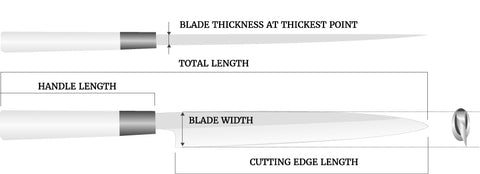We Offer DHL EXPRESS Flat Rate Shipping Worldwide. Just $10 USD for US, Canada, Australia, Asian countries. US$15 for Europe and other Countries in the world
For our U.S. Customers — No extra fees! All orders ship via FedEx DDP (duties & tariffs are covered by JCK). Enjoy fast, worry-free delivery! Learn More
We Offer DHL EXPRESS Flat Rate Shipping Worldwide. Just $10 USD for US, Canada, Australia, Asian countries. US$15 for Europe and other Countries in the world
For U.S. Customers:
At the first glance, you might think that the unfamiliar features of these Japanese traditional-style knife will mean that it is not suitable for use in your kitchen. However, Master Saji has made no compromises in the cutting performance or functionality of this unconventional looking knife.
The blade is made of Hitachi Gingami No.3 stainless steel, which is highly regarded for its edge sharpness and edge retention, in addition to its strong resistance to corrosion and low maintenance requirements.
To ensure that the stag antler handle is comfortable and secure to grip, Master Saji carefully selected the material for each handle and checked the consistency of its diameter and overall shape.
The Yanagiba is primarily used to slice boneless fish fillets for Sashimi and Sushi dishes, but it can also be used to fillet small to medium-sized fish, and is often used for skinning fish. The narrow blade and relatively acute edge angle of the Yanagiba are features which greatly reduce the effort required to cut through ingredients. As with the Sujihiki, the long blade allows the fish to be cut in one single drawing motion, from heel to tip.
The combination of cutting technique, acute blade angle, and sharp edge result in very little cellular damage in the cut surface. This is particularly important for dishes where the fish is eaten raw, because it helps to preserve the original flavor and texture of the fish.
Knife Model: Takeshi Saji Gingami No.3 Yanagiba
Blade Material: Gingami No.3
Rockwell Hardness (HRc): 58 to 59
Blade Grind and Edge Shape: Single Bevel Edge
Handle Material: Stag Handle with Brass Ring
Saya Included: No.
| Yanagiba 240mm (9.4") Total Length: 385mm Blade Thickness: 3.6mm Total Weight: 181g |
| Yanagiba 270mm (10.6") Total Length: 415mm Blade Thickness: 4mm Total Weight: 242g |
| Yanagiba 300mm (11.8") Total Length: 450mm Blade Thickness: 4mm Total Weight: 256g |

Sorry. This knife is not available for left handed version.
We believe quality and performance of Japanese knives are best in the world and hope you enjoy fine craftsmanship and spirits from your new knife. With proper cares, every Japanese knives can be your special cooking partner for long time.
Important
This is the Stainless steel blade kitchen knife, which has good rust resistance for easy maintenance. However even stainless steel blade kitchen knife has rust situation if you leave it with wet condition.
